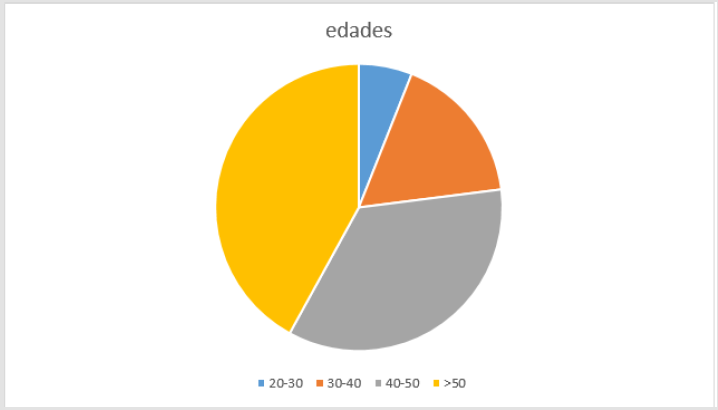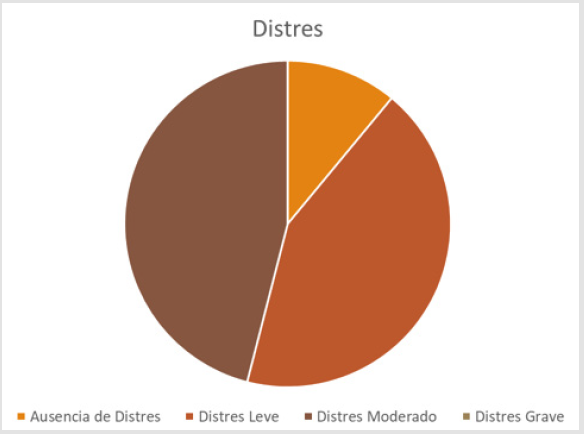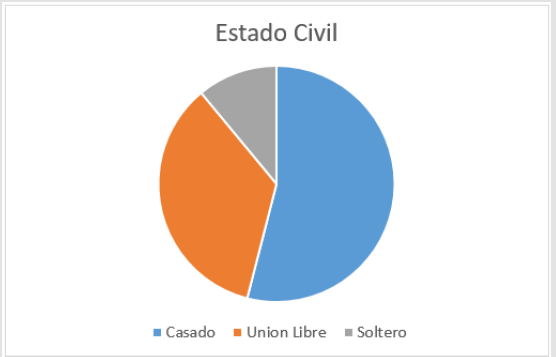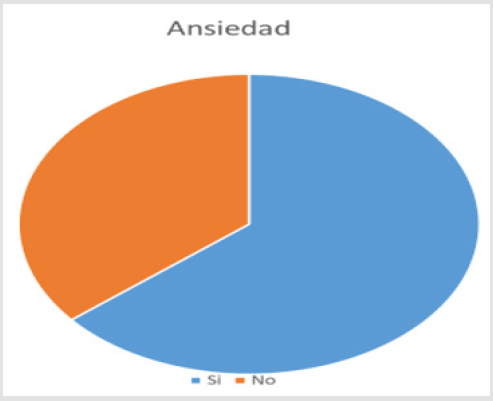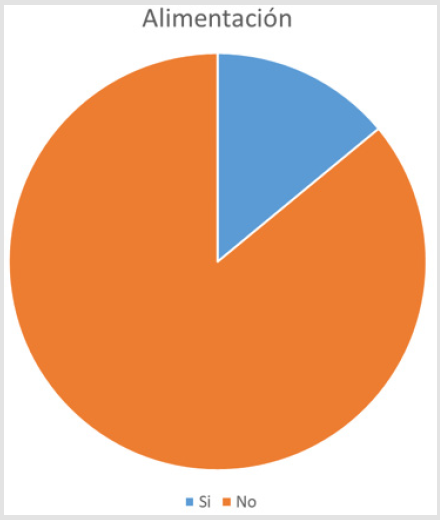Abstract
Observe and Identify patients that presented depression and anxiety using the Hospital Anxiety Diagnosis Scale (HADS), Zung & Conde scale and ASQ 15 scale on Guadalajara Regional Military Hospital during the month of April 01st to April 30th, 2019.
Methods: This is a cohort, non-experimental, observational, prospective and longitudinal study with PubMed and NCBI articles as variables. Findings: Most patients presented anxiety, most patients had a chronic illness, depression was seen mostly in patients older than 50 years old, there was inadequate diet, lack of sleep, and low distress level.
Overview: Observe and identify patients who have depression through the hospital anxiety and depression scale within the Regional Military Hospital of Specialties of Guadalajara from April 01 to April 30, 2019.
Material and Methods: Cohort and, non-experimental, observational, prospective and longitudinal study as variable articles of the NCBI and PubMed database. Finding: The questionnaire was taken in hospitalized patients during the month of April 2019 at the Regional Military Hospital of Specialties of Guadalajara.
Conclusion: It was observed mostly mild depression, the majority of the patients had anxiety, the majority had a chronic disease, fue greater the presence of depression in patients over 50 years of age, haba lack of adequate diet, and exercise of sleep habits.
Introduction
Depression and anxiety affect most people around the world, it is characterized by a presence of fear, loss of interest, feelings of guilt or self-esteem that are more commonly associated with sleep disorders, lack of appetite, lack of energy or difficulty concentrating. Depression can become chronic or recurrent and difficult the overall performance daily, or capacity to live day by day, in its most dangerous form it can lead often to suicide and its lowest form it can be treated with medication and professional psychotherapy. (Health, Depression , 2017). Anxiety is one of the major disorders and its characterized by persistent concern during any activity or routine it is difficult to treat and it can affect the way a person feels physically.(mayoclinic, 2018).During this investigation we will observe a sample that was taken on the Guadalajara Regional Military Hospital during the month of April a sample of 56patients presented anxiety and depression according to three scales that were applied.
HADS (Hospital Anxiety Diagnosis Scale)
The Hospital Anxiety Diagnosis Scale is an auto applicable questionnaire integrated by 14 items with subscales of seven items one for impared questions and one with pair questions for depression, the authors for this scale are Zigmund and Snaith who proposed this in 1983 and defined the concepts of anxiety and depression the objective of this scale is to identify if the patient has being tensed, concerned or frightened in any way, the8 items that form the depression subscale are centered around anhedonia with a maximum score that binds from 0 to a 39 score, in which0-9 score means lack of stress, 10-19 means low stress, 19 to 29 means mild stress and 30 to 39 means anxiety and severe depression.
Zung & Conde Scale
Its and auto applicable scale consisting of 20 phrases related to depression formed by 10 negative phrases and 10 positive phrases which relate to strong somatic symptoms and 8 cognitive items for each group contemplating the scale with two items referee to mood and other psychotic symptoms [1].
Depression and Anxiety
Severe Depression: Its characterized by a combination of symptoms that interfere with capacity to work, sleep, study, eat and enjoy daily basis activities.
Dysthymic Disorder
Its characterized by symptoms that is somewhat between 2 years and beyond but less severe, it incapacitates the patient and it prevents him from having a normal life accompanied by a severe depression episode during life.
Psychotic Depression
Occurs during severe depression and its accompanied by some for of psychosis accompanied by delirium and hallucinations.
Seasonal Depression
Its characterized by depression that appears during Winter or times of decreased sunlight.
Bipolar Disorder
Its characterized by maniac depression disorder that it accompanied by cyclic mood swings and depression state, its often seen in patients with cancer, HIV/Aids and Parkinson.
Symptoms
Emotional
Are accompanied by guilt ideas, a severe disease, ideas of sadness never going to heal, loneliness, lack of concentration because patient will eventually die.
Physical
Difficulty eating, or basic needs, weight loss, mood swings.
Negative Thoughts
This is mostly seen in older patients, self steem problems, most cases are seen in patients over 60 years old, or below 45 years old.
Methods
This is a cohort, non-experimental, observational, prospective and longitudinal study in which scholarity was evaluated, cause of hospitalization, age, previous diseases, job and the days patient had been hospitalized.56 patients both men and women older than 18 years old were evaluated during this study, a random sample was taken in which every patient has the same possibility of presenting depression or anxiety. Patients hospitalized in the women’s hospital room, the men’s hospital room, and the room that consisted of patients that had the rank of major in the Mexican armed forces or above excluding patients that belonged to Intensive care unit, using the Hospital Anxiety Diagnosis Scale , Zung & Conde Scale and ASQ- 15 Scale were used during this study [2-5].
Justification
This study was conducted to observe what was the impact of being hospitalized and the relation it had with depression and anxiety in patient, we pretended to find viable date that allowed us to expose the hospital environment and the presence of disease, anxiety and depression.
Result
Figure 1 Patients with depression. Fuente. Zung & Conde Depression Scale. 62% of the patients did not present depression 34 patients, 16 patients had low depression 29%, also 8% of the patients had moderate depression which represented 4 patients also 2 of the patients representing 1% presented what could be considered as severe depression [6-10] [Figure 2-7].
Figure 1: Patients with depression. Fuente. Zung & Conde Depression Scale. 62% of the patients did not present depression 34 patients, 16 patients had low depression 29%, also 8% of the patients had moderate depression which represented 4 patients also 2 of the patients representing 1% presented what could be considered as severe depression.
Figure 2: Most common ages seen during study.
Note:
• 42% of the patients presented depression were over 50 years old.
• 35% of the patients presented depression between 40-50 years of age.
• 17% of the patients that presented depression had between 30-40 years of age.
• 6% of the patients had between the ages of 20 to 30 years of age.
Figure 3: Patients that had some sort of stress evaluated by HADS scale.
Note:
• 43% of the patients had lack of stress.
• 46% of the patients had low level stress.
• 11% of the patients had moderate stress.
• 0% of the patients had severe stress.
Figure 4: Most common diseases (12 patients didn’t have an illness).
Note:
• Hypertension: 16
• Diabetes Mellitus:12
• Renal Insuficiency:4
• Ulcerative Colitis:1
• Hepatic Cirrosis:3
• Lung Cancer: 3
• Cervical Cancer:1
• Fractures: 4
Figure 6: Patients that presented anxiety.
Note:
• 64% presented anxiety 35 patients.
• 36% did not present anxiety 21 patients.
Conclusion
Referred to this subject we understand this two disorders are preventable and the patient if its treated and seeks help with time he can change his daily habits, our suggestions are that a stable lifestyle with a well balanced diet consisting of fruit, vegetables, meat, daily exercise, stable relationships with family and friends, alongside no work stress, in addition to a good mental stability can lead to a good life and to prevent this type of disorders also to prevent chronic illness which were seen during this study on most patients that indicated feeling anxious or depres sed, if they are in this state also to take medication on time and with the help of family members and friend [11-13].
a) We observe most patients presented a low depression
level.
b) Most patients presented anxiety.
c) Most patients had a chronic illness.
d) Patients over 50 years old presented higher depression
levels.
e) Most patients were married.
f) Most patients had low level stress level
Acknowledgement
None.
Conflict of Interest
No conflict of interest.
References
- Roza M (2019) escala autoadminisrada de depresion psicomag. Escala de Zung y Conde que es.
- Carolina Casanova (2017) Screening for symptoms of anxiety and depression in patients admitted to a university hospital with acute coronary syndrome. Trends Psychiatry Psychother 39(1).
- (2008) Grupo de Trabajo de Guia de Practica Clinica para el manejo de pacientes con trastornos de ansiedad en atención primaria. Plan Nacional para SNS. Guias de practica clínica en SNS.
- (2016) Servicio de Psiquiatria y Psicologia Hospital Universitario Dexeus
- National Institute of Mental Health. Departamento de Salud y Servicios Humanos de los Estados Unidos.Trastornos de Ansiedad.
- (2012) Enfocando la depresión como problema de salud publica en México (2012) Fernando A. Wagner. Catalina Gonzá
- Guillermo Hernandez, Gricel, Monica Kimmelman (2005) Trastornos de ansiedad en pacientes hospitalizados en Medicina Interna, Orellana Rev. mé Chile 133(8) Santiago ago.
- Miriam Costas, Veronica Prado, Jose Manuel Crespo (2013) Ansiedad y depresión entre los pacientes hospitalizados en el complejo hospitalario de Ferrol.
- Sílvia Abduch Haas, Daniela Centenaro Levandowski, Antônio Nocchi Kalil (2017) Ansiedad, depresión, percepción y sentimientos de mujeres con cáncer indicadas para cirugía de exenteración pé
- Author links open overlay panel.
- YeLi, Mei RongLv,YanJinWei, LingSun, JiXiang Zhang, et al. (2017) Dietary patterns and depression risk: A meta-analysis. Psychiatry Research 253: 373-382.
- General IMSS. Consejo de Salubridad Guia de referencia rapida guia practicaclínica.
- Organización Mundial de la Salud. Que es depresión y ansiedad.

 Review Article
Review Article
